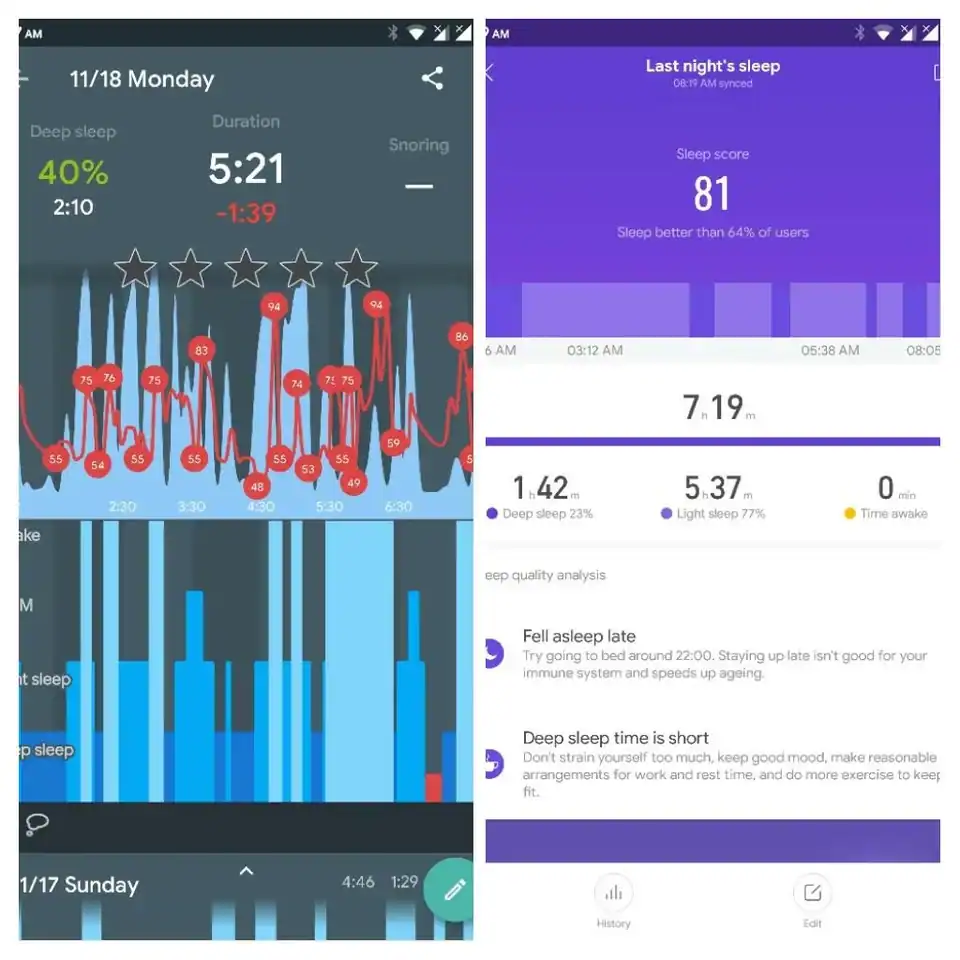How Does the Xiaomi Mi Band Track Sleep?:- Sleep is an essential aspect of our daily lives, affecting both our physical and mental well-being. As technology continues to advance, it has become easier than ever to monitor our sleep patterns and gather valuable insights into our sleep quality.
One such device that has gained popularity for its sleep-tracking capabilities is the Xiaomi Mi Band. In this blog post, we will explore how the Xiaomi Mi Band tracks sleep and how you can utilize this feature to improve your sleep hygiene and overall health.
The Importance of Sleep Tracking
Before we dive into the specifics of how the Xiaomi Mi Band tracks sleep, let’s first understand why sleep tracking is important. Sleep plays a crucial role in our overall health, affecting our mood, cognitive function, productivity, and physical well-being. By tracking our sleep patterns, we gain valuable insights into our sleep quality, duration, and efficiency. This information can help us identify any sleep disruptions or issues, allowing us to take necessary steps to improve our sleep hygiene and overall well-being.
How does the Xiaomi Mi Band track sleep?
The Xiaomi Mi Band utilizes advanced sensor technology and algorithms to accurately track and analyze your sleep patterns. Let’s take a closer look at the key components and features that enable this device to monitor your sleep:
1. Accelerometer Sensor
The Xiaomi Mi Band is equipped with a highly sensitive accelerometer sensor that measures your movements and body vibrations during sleep. By analyzing these movements, the device can determine the different sleep stages you go through during the night, including light sleep, deep sleep, and REM sleep.
2. Heart Rate Monitor
Another important component of the Xiaomi Mi Band is its heart rate monitor. This feature allows the device to measure your heart rate throughout the night, providing insights into your overall sleep quality and detecting any irregularities or fluctuations.
3. Sleep Tracking Algorithms
The Xiaomi Mi Band incorporates advanced algorithms that analyze the data collected by the accelerometer sensor and heart rate monitor. These algorithms take into account factors such as movement patterns, heart rate variability, and sleep duration to accurately determine your sleep stages and overall sleep quality.
4. Sleep Stage Detection
Based on the data collected and analyzed, the Xiaomi Mi Band can identify the different sleep stages you experience during the night. For example, it can detect when you transition from light sleep to deep sleep or when you enter the REM (rapid eye movement) sleep stage. This information is then presented to you in a comprehensive sleep report.
5. Sleep Duration and Efficiency
In addition to tracking your sleep stages, the Xiaomi Mi Band also provides valuable information about your sleep duration and efficiency. It can calculate the total time you spend asleep, as well as the time you spend in each sleep stage. This data helps you understand whether you are getting enough sleep and how well you are utilizing your time in bed.
6. Sleep Insights and Recommendations
One of the key benefits of using the Xiaomi Mi Band for sleep tracking is the actionable insights and recommendations it provides. Based on your sleep data, the device can offer personalized suggestions to improve your sleep hygiene, such as establishing a consistent sleep schedule, creating a relaxing bedtime routine, or adjusting your sleep environment.
How to Activate Sleep Monitoring on Xiaomi Mi Band
Before you can activate sleep monitoring, it’s crucial to ensure your Mi Band is properly set up and paired with your smartphone. Here are the steps to follow:

Step 1: Ensure your Mi Band is Properly Set Up
- Download and install the Mi Fit app on your smartphone. It is available for both iOS and Android devices.
- Open the app and create an account if you don’t have one already. Sign in with your credentials if you already have an account.
- Follow the on-screen instructions to pair your Mi Band with your smartphone. Make sure Bluetooth is enabled on your device.
Once your Mi Band is successfully connected to your smartphone, you’re ready to move on to the next step.
Step 2: Access Sleep Monitoring Settings
To activate sleep monitoring on your Mi Band, you need to access the sleep monitoring settings on the Mi Fit app. Here’s how:
- Open the Mi Fit app on your smartphone.
- Tap on the profile icon at the bottom right corner of the screen.
- Scroll down and select “Mi Band” under the “My Devices” section.
- Tap on “Sleep assistant” to access the sleep monitoring settings.
Step 3: Enable Sleep Monitoring
Now that you’ve accessed the sleep monitoring settings, it’s time to enable this feature on your Mi Band. Follow these simple steps:
- In the sleep monitoring settings, toggle the switch next to “Sleep assistant” to enable it.
- You will see a notification on the Mi Band screen asking you to wear it while sleeping for accurate monitoring. Confirm by tapping on the checkmark.
Congratulations! You have successfully activated sleep monitoring on your Xiaomi Mi Band. Now let’s explore some additional tips and features to help you get the most out of this feature.
How do I View my Sleep Data from my Mi Band?
You can view your sleep data from your Mi Band through the Mi Fit or Zepp Life app. These apps will sync with your Mi Band and display your sleep data, including your sleep duration, sleep stages, and sleep score.
To view your sleep data from your Mi Band, you will need to use the Mi Fit or Zepp Life app. Here are the steps on how to do it:
- Open the Mi Fit or Zepp Life app.
- Make sure that your Mi Band is connected to your phone.
- Tap on the “Sleep” tab.
- You will see a summary of your sleep data for the current day.
- You can also view your sleep data for the past week, month, or year.
- Tap on a day to see more detailed information about your sleep.
Your sleep data will be displayed in a graph and a table. The graph will show you your sleep duration and sleep stages over time. The table will show you more detailed information about your sleep, such as your sleep score, deep sleep duration, REM sleep duration, and awake time.

- Sleep duration: The total amount of time you slept.
- Deep sleep: The amount of time you spend in deep sleep.
- Light sleep: The amount of time you spend in light sleep.
- REM sleep: The amount of time you spend in REM sleep.
- Sleep interruptions: The number of times you wake up during sleep.
- Sleep score: A score that indicates the overall quality of your sleep.
You can also use the apps to set sleep goals and track your progress over time.
Tips for Optimizing Sleep Tracking with the Xiaomi Mi Band
To make the most of your sleep-tracking experience with the Xiaomi Mi Band, here are some tips to consider:
1. Wear the Mi Band Properly
To ensure accurate sleep tracking, it is important to wear the Xiaomi Mi Band properly. Make sure the device is snug but comfortable on your wrist and positioned in a way that allows the sensors to collect data effectively. Avoid wearing it too loosely or too tightly, as this may affect the accuracy of the measurements.
2. Keep the Band Charged
To ensure uninterrupted sleep tracking, it is essential to keep your Xiaomi Mi Band charged. Regularly check the battery level and charge the device as needed. Fortunately, the Mi Band has a long battery life, so you won’t have to worry about charging it every day.
3. Sync and Review Your Sleep Data
After waking up, sync your Xiaomi Mi Band with the accompanying mobile app to review your sleep data. Take some time to analyze the sleep report, paying attention to the sleep stages, duration, and efficiency. This will help you identify any patterns or issues that may be affecting your sleep quality.
4. Establish a Bedtime Routine
To optimize your sleep quality, it is beneficial to establish a consistent bedtime routine. The Xiaomi Mi Band can help you track your progress and adherence to your routine. Set a consistent sleep schedule, avoid stimulating activities before bed, and create a calm and comfortable sleep environment.
5. Utilize Sleep Insights and Recommendations
Take advantage of the personalized insights and recommendations provided by the Xiaomi Mi Band. Implement the suggested changes and monitor how they impact your sleep quality over time. Experiment with different strategies and track your progress using the sleep-tracking feature.
Conclusion
The Xiaomi Mi Band offers an impressive array of features for sleep tracking, allowing you to gain valuable insights into your sleep patterns and quality. By utilizing the accelerometer sensor, heart rate monitor, advanced algorithms, and sleep stage detection, the device provides an accurate representation of your sleep stages, duration, and efficiency. Armed with this knowledge, you can make informed decisions to improve your sleep hygiene and overall well-being.
Remember to wear the Mi Band properly, keep it charged, review your sleep data regularly, establish a bedtime routine, and utilize the personalized insights and recommendations provided. So, go ahead, put on your Xiaomi Mi Band, and embark on a journey towards better sleep.


![How to Turn Off Water Lock on Fitbit Inspire 2 [ 3 Easy Steps] 6 Read more about the article How to Turn Off Water Lock on Fitbit Inspire 2 [ 3 Easy Steps]](https://smartwatchinsight.com/wp-content/uploads/2023/08/How-to-Turn-Off-Water-Lock-on-Fitbit-Inspire-2-1-300x169.webp)

![How To Charge Oura Ring Without Charger?[5 Best Ways] 8 Read more about the article How To Charge Oura Ring Without Charger?[5 Best Ways]](https://smartwatchinsight.com/wp-content/uploads/2023/07/How-To-Charge-Oura-Ring-Without-Charger-300x169.webp)
